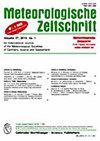基于二十面体非流体静力学模型(ICON)风的拉格朗日输运
IF 1.7
4区 地球科学
Q4 METEOROLOGY & ATMOSPHERIC SCIENCES
引用次数: 0
摘要
在化学气候模式中准确地表示成分的大气传输是一项挑战。尤其是要真实地表示大气传输障碍,如极地涡旋边缘或对流层顶。如果采用拉格朗日方法来表示传输,就可以避免表示传输障碍的数值问题。在这里,我们利用模块化地球子模型系统(MESSy),首次实现了由二十面体非静水模型(ICON)的水平风和垂直速度驱动的拉格朗日传输模型(同温层化学拉格朗日模型,CLaMS)。从(自由运行的)ICON 模型中的温度趋势推导出的绝热加热率可以确定垂直速度,并以等熵(绝热)坐标进行传输计算。推导出的等熵加热率与ERA5再分析的年均值在质量上非常吻合,但仍存在一些差异。此外,模拟结果与微波测边仪(MLS)卫星观测到的一氧化二氮之间总体上是一致的,特别是在极地涡旋边缘的一氧化二氮梯度方面。总体而言,南极漩涡及其边缘的相关传输障碍在模拟中得到了很好的体现,尽管模拟的极地漩涡比观测到的要大。观测结果与拉格朗日模拟结果之间的一些差异可能是由基本的 ICON 风造成的。ICON/MESSy-CLaMS耦合传输方案允许对自由对流层和平流层的示踪剂分布进行逼真的模拟,包括表示跨传输障碍的示踪剂梯度,这是经典欧拉方案通常较难获得的特征。本文章由计算机程序翻译,如有差异,请以英文原文为准。
Lagrangian transport based on the winds of the icosahedral nonhydrostatic model (ICON)
Representing atmospheric transport of constituents accurately in a chemistry climate model is a challenge. This is true in particular for a realistic representation of atmospheric transport barriers, e.g. at the edge of the polar vortices or at the tropopause. When transport is represented employing Lagrangian methods, numerical problems representing transport barriers may be obviated. Here, we present a first implementation of a Lagrangian transport model (the Chemical Lagrangian Model of the Stratosphere, CLaMS) driven by horizontal winds and vertical velocities of the icosahedral nonhydrostatic model (ICON) using the Modular Earth Submodel System (MESSy). The diabatic heating rates deduced from the temperature tendencies in the (free-running) ICON model allow vertical velocities to be determined and transport calculations in isentropic (diabatic) coordinates. The deduced diabatic heating rates agree qualitatively well with ERA5 reanalysis values in the zonal annual mean, but some discrepancies remain. Further, there is an overall agreement between the simulation and N2O observations by the Microwave Limb Sounder (MLS) satellite instrument; in particular regarding N2O gradients at the edge of the polar vortex. Overall, the Antarctic vortex and the associated transport barrier at its edge are well represented in the simulation, although the simulated polar vortex is larger than observed. Some differences between the observations and the Lagrangian simulation may be caused by the underlying ICON winds. The coupled ICON/MESSy-CLaMS transport scheme allows realistic simulations of tracer distributions in the free troposphere and in the stratosphere, including the representation of tracer gradients across transport barriers, a feature generally more difficult to obtain by classical Eulerian schemes.
求助全文
通过发布文献求助,成功后即可免费获取论文全文。
去求助
来源期刊

Meteorologische Zeitschrift
地学-气象与大气科学
CiteScore
2.80
自引率
8.30%
发文量
19
审稿时长
6-12 weeks
期刊介绍:
Meteorologische Zeitschrift (Contributions to Atmospheric Sciences) accepts high-quality, English language, double peer-reviewed manuscripts on all aspects of observational, theoretical and computational research on the entire field of meteorology and atmospheric physics, including climatology. Manuscripts from applied sectors such as, e.g., Environmental Meteorology or Energy Meteorology are particularly welcome.
Meteorologische Zeitschrift (Contributions to Atmospheric Sciences) represents a natural forum for the meteorological community of Central Europe and worldwide.
 求助内容:
求助内容: 应助结果提醒方式:
应助结果提醒方式:


